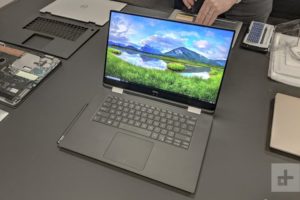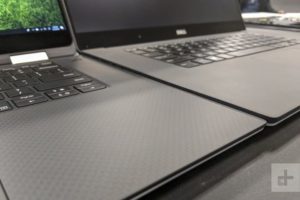The Dell XPS 13 is hands-down our favorite laptop, and it’s the kind of product we recommend to just about anyone. But what if you’re interested in something even more forward-thinking? What about a PC that’s a bit more…experimental?
From a distance, the XPS 15 2-in-1 might not look like that device. It carries over many design characteristics from the XPS 15, along with the convertible form factor of the XPS 13 2-in-1. In fact, from the outside, you might not be able to tell them apart. Convertible form factors are as common today as traditional clamshells, and they are often added to existing designs like a feature, morphing an existing design into a 2-in-1 with minimal tweaks.
Not the XPS 15 2-in-1. For Dell, it isn’t just a 2-in-1 version of the XPS 15 — it’s a way of experimenting with future technology without having to sacrifice the familiarity of its premium laptop line. When you look at it, you see the future of the XPS line – or, at least, one possible future.
The horsepower you didn’t know you needed
As an experimental product, Dell chose to implement a brand-new type of processor from Intel — and it’s the first 2-in-1 (or laptop) to use it. The Intel G-series processors are a new breed, integrating an Intel CPU with AMD Vega graphics, all on the same component.
“It allowed us to do something that we couldn’t have done with a traditional implementation of discrete graphics,” said Donnie Oliphant, the Marketing Director of XPS over at Dell. “You take a GTX 1050 Ti or 1060 and try to put it into this form factor — it doesn’t fit.”
Adopting this new chip gives the XPS 15 2-in-1 surprising graphics capability in an impressively thin form factor. But regardless of how thin, small, or light Dell wants to make the XPS 15 2-in-1, that was never the primary drive. The designers, engineers, and executives in the XPS team seem much more interested in holding performance and size in balance. There are certain aspects, most notably, in build quality and performance, that Dell wasn’t willing to compromise on.
“I always joke with folks, saying that if I I’ve ever brought you the thinnest or lightest of anything, I’ve lost my mind,” says Oliphant. “I’ve just traded off that the customer cares about. We can always do the thinnest — it’s just decisions. Being the best? That’s difficult.”



The XPS team has a history with gaming-capable laptops, most notably, with the previous XPS 15. It offered an optional GTX 1050, which could play many games at acceptable framerates. With the XPS 15 2-in-1, however, Dell wasn’t interested in throwing in a cheap graphics card, like other manufacturers have done. Asus, for example, has released a couple of very thin laptops that use a discrete Nvidia MX150 to power the graphics.
“We’re interested in driving new experiences, not just doing something for the sake of doing it,” says Frank Azor, a VP Dell. “A lot of those MX150 implementations are leaning on Nvidia’s brand equity to fool customers into thinking that machine is capable of doing something it really can’t, which is play games decently. It’s not a very decent gaming machine. If we could do something like that in the form factor here, but deliver a true gaming-capable proposition, then we’d probably do it. We’re not there yet.”
Azor is a gamer himself, starting at Alienware as a teenager before growing with the company through the acquisition by Dell. He now oversees the XPS, Alienware, and Dell Gaming lines. Will the implementation of the Intel G-Series chip, Azor is bringing gaming to systems that seem far too small and versatile to handle a round of Fortnite.
“What we’ve done in this 15-inch space is truly gaming-capable. I play Overwatch, PUBG, and a bunch of stuff on these. They are great gaming computers. Not as good as what we build on Alienware or even G7 gaming, but very capable. Hard to do that with a MX150 here, especially when you put a 4K screen on it.”
Of course, high-performance graphics always comes at a cost. A monetary cost, yes — but also a thermal cost. Dell had to pioneer an experimental cooling solution to make sure every last drop of performance could be eked out of the G-series chip.
The magic materials that keep it cool
Dell has boasted about its specialized implementation of Gore material since it was announced in the XPS 13 at CES. On the XPS 15 2-in-1, Dell has used even more Gore to act as a unique cooling agent that weighs almost nothing.
“It is literally, no exaggeration, space age material,” says Oliphant. “The aero-gel, which is mixed in with this material to create the thermal barrier, was used on the Mars rover. NASA uses this to insulate their devices from extreme heat or extreme cold. We use it in conjunction with graphite, which is a heat spreader. We’ll put the Gore on the aluminum side and use graphite on top to spread the heat over the Gore, and the Gore insulates that heat from getting to the customer.”
Because the XPS 15 2-in-1 is an experimental platform, Dell doesn’t seem afraid to dump some extra money into the technology here. Just how much? Well — Donnie Oliphant stated that there’s around three or four times as much as Dell would typically put in a system like this.
“There’s over 60 dollars of thermal material in this product,” said Oliphant. “Three heat pipes, one of the largest RAGs we’ve shipped in a non-gaming or Precision device. There’s a tremendous amount of technology and cost that we invested in the thermal solution alone here. It’s the most complex thermal design we’ve done for a consumer product.”
Oliphant and Azure assured us Dell is investing heavily in the thermal components of this unit on a financial level. He was clear the amount of money spent wasn’t something the company would immediately implement at the volume of more mainstream XPS units.
These aren’t improvements that many people who buy an XPS 15 2-in-1 will notice, but they will notice improved performance. For that reason, these are investments and financial risks the XPS team seems ready to take.
“Customers don’t care,” said Oliphant. “But those are the investments we will make in XPS.”
An experimental keyboard
While the graphics and thermal solution won’t turn anyone off, the XPS 15 2-in-1’s keyboard will be more divisive. Rather than using a traditional, higher-travel keyboard, Dell went with something closer to the butterfly switch keys of recent MacBooks.
Reception to Apple’s keyboard wasn’t universally loved, but Dell didn’t shy away from taking the conceptual framework behind that keyboard and running with it.
“This is a new frontier,” says Oliphant. “I’m glad Apple did what they did a couple of years ago. They started to pave a path for alternatives. Magnets were the idea of a replacement to deliver a perfect deflection curve that’s tuneable, while making it feel like it’s more than the 0.7mm travel that we have in the design.”
The feel of the keyboard will be strange unless you’re coming straight from a MacBook. Even Azor admits that it needs a couple of hours to become used to. With just 0.7mm of travel, the keys feel more like clicky buttons than traditional switches. While fans of high-travel keyboards will no doubt cringe at how quickly they bottom out, the keys do inspire confidence in quick, precise typing, thanks to the feedback mechanism of the magnets.
“It’s always a value trade-off between thin system versus a long-stroke keyboard experience,” says Justin Lyles, the VP of Consumer Design. “I say that specifically with the long stroke because what we’re trying to push here is to change the paradigm of having to have a long stroke to have a good keyboard. We’re trying to find the sweet spot. You can actually go to a shorter stroke if you focus on other things like the force curve of the key — the feedback you get when you push the key.”
 While the keys use a similar butterfly-like scissor mechanism to attach the keys to the base, the feedback pressure is provided by an entirely new system that uses magnets. The magnetic system is the end of a winding research path that had several dead ends.
While the keys use a similar butterfly-like scissor mechanism to attach the keys to the base, the feedback pressure is provided by an entirely new system that uses magnets. The magnetic system is the end of a winding research path that had several dead ends.
“Five or six years ago, we were chasing down a different technology path, which was the angled travel. It was on a ramp,” says Lyles. “The keys didn’t go vertically down, they actually ramped down towards the user at an angle. From a force stand point, you could go on an angle with 0.7mm stroke, it felt like double that. We chased that for a while, but it didn’t really pan out very well. That’s when we shifted gears and moved into magnetics.”
Dell seems certain this is the future of keyboards. Lyles is looking ahead, anticipating the kind of trends in technology that will shape the future of input methods. Fans of long keystrokes won’t be happy about what he sees in his crystal ball.
“In the future, you’re going to start seeing a lot more interesting things,” he says. “Maybe the key doesn’t have to travel in z-direction at all. Maybe it travels in different directions. Maybe you can retract and lock the key when you don’t need it. There are different things you can do that’ll be very interesting.”
Dell is betting its experiments will pay off
Thanks to the success of the thinned bezels and relocation of the webcam, the XPS team is now taking risks with a bit more confidence. That, however, doesn’t mean Dell is ready to implement these advanced, expensive technologies on the bread-and-butter XPS products. The XPS 13 and XPS 15 will always remain the more mundane options — and Dell isn’t planning to retire them anytime soon.
“To early adopters, they’ll be like, ‘This is fucking amazing.’ And it is,” says Azor. “To folks who are a little more conservative, it might not be the right solution for them. We’ll see.”
The XPS 15 2-in-1 won’t sell as many units as the XPS 13, and it was never meant to. But it is a glimpse into the future of laptops – or at least, Dell’s vision of it.


